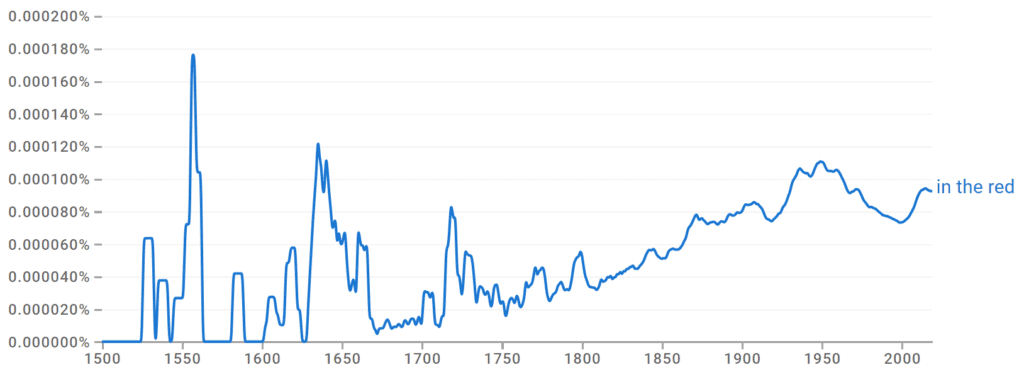The idiom in the red means being in debt or operating at a loss, usually in terms of finances. An idiom is a phrase or expression with a figurative meaning separate from the literal meaning of the individual words. Idioms play a crucial role in the English language, making it rich, vibrant, and more nuanced.
This idiom originates from the accounting world, where losses were traditionally recorded in red ink. Its proper usage involves describing a condition of financial deficit. For example, “After several bad investments, the company ended up in the red.”
Financial idioms like in the red are more than just financial jargon. They’re a testament to the ever-evolving nature of language, reflecting the economic realities of their times. But understanding its deeper meaning and origin story will help you understand how to use them in a sentence.
Keep reading as we delve deeper into its meaning, origin, modern implications, literal and figurative uses, synonyms, and some sentence examples.
What Does ‘In the Red’ Mean?

In the realm of finance and accounting, the idiom in the red carries a significant weight, denoting a situation of financial deficit. However, while its conceptual foundation remains the same across regions, its application has subtle nuances based on the regional variety of English.
In American English
The phrase in the red is a direct reference to a financial deficit. It implies a situation where debts or liabilities exceed the assets or profits. It is often used to depict businesses or organizations that are not profitable or individuals in debt.
In British English
In the red, while maintaining the same basic connotation of financial loss, is frequently used specifically to describe bank accounts. In this context, it indicates a bank account balance that has dipped below zero, suggesting an overdraft situation.
Literal vs. Idiomatic Meaning
Literally, red is a color, and when talking about finances, the color would be used to highlight negative balances.
But in idiomatic contexts, in the red goes beyond mere hues, hinting at all sorts of monetary challenges. Culturally, the color red is often linked to warning or danger, aptly reflecting the precarious nature of being in debt. Basically, red is usually bad, whether literal or figurative.
What Is the Origin of ‘In the Red’?

The idiom in the red actually has a literal origin, deriving from the use of red ink to show negative figures during the 1500s.
When and Where Did ‘In the Red’ Originate?
This phrase comes from a time before the use of Excel spreadsheets and accounting software when accountants used red ink pens to highlight negative balances in physical ledgers.
How Did ‘In the Red’ Transition From Ledgers to Everyday Speech?
As businesses flourished and financial reporting became common, the term naturally seeped into colloquial use, reflecting economic health or the lack thereof. Sometimes, heavily used terms and expressions just stick around, no matter how much the world evolves.
Examples of How ‘In the Red’ Is Used
Typically, the idiom is used to describe financial health. For instance, “The company has been in the red for the past three quarters.” Let’s look at other common contexts and notable examples of this idiom in use.
In What Contexts Is ‘In the Red’ Commonly Used?
This phrase often pops up in business discussions, financial reports, or even casual conversations about personal finances.
1. If you and your partner were combing through your finances to see if you could afford a new car but realized your credit was racked up, then you’d say, “We can’t afford a new car until we’re no longer in the red.”
2. If you owned a small business and someone asked how things were going, you might respond, “Well, I’m in the red right now until I turn a profit or at least break even.”
Are There Notable Examples of ‘In the Red’ in Literature and Media?
Most television shows and movies with office settings will use the idiom in the red at least once. But here are some instances of it in the media.
Investors came back from the weekend in a ho-hum mood Monday, as many well-known local companies’ shares finished in the red, but a few notable names ended the day’s trading in positive territory. (The Mercury News)
Council member Mike Gaskill said as of May 10, the health fund was showing a negative balance and is currently in the red by $47,000. (The Herald Bulletin)
The town of Gene Autry approved its $42,000 budget in a unanimous council vote ending the fiscal year and beginning the next in the black. (The Daily Ardmoreite)
Which Idioms and Phrases Relate to ‘In the Red’?
Here are some other financial idioms that are related to in the red:
- In the black: This is the opposite of in the red. When an individual or business is in the black, they are profitable or at least breaking even.
- Break the bank: To use up all of one’s money.
- Pay through the nose: To pay too much for something.
- Foot the bill: To cover the cost of something large and shared among several people.
- A run for your money: A phrase used to indicate that one person or thing is competing against another, and the outcome is not yet known.
- Cash cow: A business or project that generates a continuous flow of money or a high proportion of overall profits compared to the amount of money invested in it.
- Bring home the bacon: To earn a living, particularly for one’s family; to be successful, especially financially.
- Money doesn’t grow on trees: A phrase used to express to someone that money is a resource that must be earned and is not easily acquired.
Synonyms
- Running at a loss
- In the negative
- Underwater
- In debt
- On the rocks
- Living hand to mouth
- Tighten one’s belt
- Drowning in debt
Antonym
- In the black
- In the green
- Profiting
- Making a killing
- Laughing all the way to the bank
- Financially stable
- Debt-free
- Running a surplus
Common Misinterpretations
There aren’t a ton of misconceptions surrounding the idiom in the red, but some are tied to the color itself. If someone didn’t know what the idiom meant, they might consider it a positive thing since red is a color used to show love.
How Should ‘In the Red’ Be Structured Grammatically?
The idiom in the red is commonly used as a prepositional phrase and can function as an adverb or adjective within a sentence. Generally, it’s used to describe a financial situation where expenses exceed income, or an individual or company owes more money than they have.

Here are some examples:
- As an adjective phrase modifying a noun: “The company’s account is in the red this quarter,” where in the red describes the noun account.
- As an adverbial phrase modifying a verb: “The company ended up in the red after investing heavily in new projects,” where in the red modifies the verb end up.
In both cases, in the red is positioned in the sentence where descriptors or qualifiers typically reside.
Why Are Financial Idioms Essential in Business Conversations?
Financial idioms are important to business because they simplify complex financial situations succinctly, helping create clear and concise communication in the business world.
The Bottom Line
Financial idioms like in the red offer a vivid snapshot of the socio-economic contexts they arise from, enriching our language with their nuanced meanings. Having dived into the deeper layers of the idiom in the red, we have unraveled its meaning, origin, and its contemporary implications.
These insights will equip you to use such idioms more effectively, enhancing your command of the English language. As language continues to evolve, embrace these expressions, for they are the lifeblood that keeps it dynamic and robust. Keep learning, for the language journey and its rewards are endless!
Check out some others we covered:
